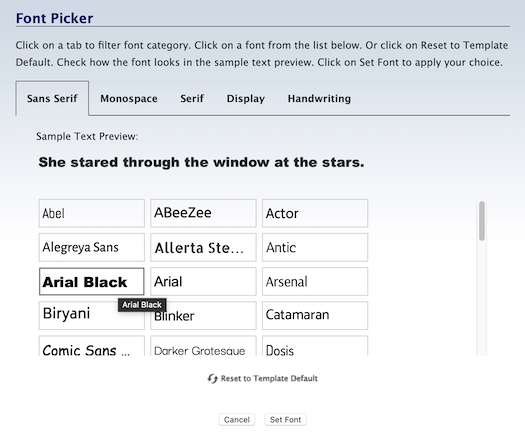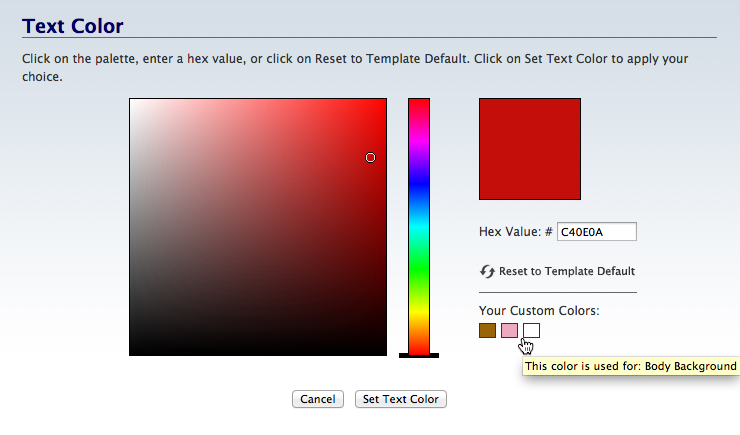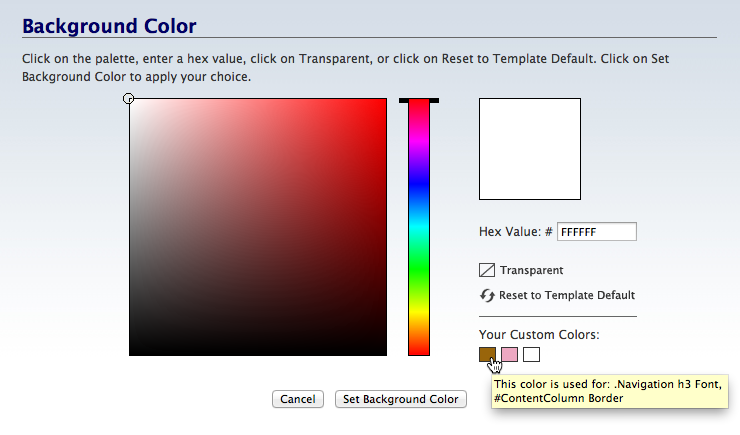Styling Ordered Lists
Contents
Styling Ordered Lists
Clicking anywhere in the ordered list (the list after the H3 headline) allows you to style all the numbered lists on your BB2 pages.
You can select how you want the text to appear, what style of numbers (or letters, or none at all), the background for your lists, and how much space you want between the numbers and the list items.

If you're ever unsure what a button does, hover over it for a second. Its function will appear as a tooltip.
Here's an example of an ordered list...
-
First list item
-
Second list item
-
Third list item
Text
With the Text tools, you can customize the following for ordered lists...
-
font type
-
font size
-
text color
-
text alignment
You can also customize other options by opening the Advanced Styles overlay.
![]()
Font Picker
- Click on the A button.
-
Click on a tab to review the fonts available to you. Hover over a font to preview it. Click on a font to select it.
Or click on Reset to Template Default to return to the default font. - Click on Set Font to save this selection, Cancel to close the tool and make no change.
Click on the A button to change the font of your text. An overlay window opens on top of your template.
Click on a tab to see the fonts in that type of font. Be sure to scroll down to see the entire list. These font categories include...
- Sans Serif (Arial, Verdana, etc.)
- Monospace (Courier, etc.)
- Serif (Palatino, Georgia, etc.)
- Display (many of these make good headline fonts)
- Handwriting (handwriting and printing fonts)
- System Fonts (web-safe fonts from the Sans Serif, Serif and Monospace categories)
Preview each font by hovering over its name and viewing the preview text.

Select the font you want to use. It will now have a red border.
Click on Set Font to save your selection.
The overlay window will close and all the filler text in your template will immediately appear with the selected font.
The system fonts load faster, and will create fewer reports (if any) in the Core Web Vitals section of Google Search Console and PageSpeed Insights.
The remaining fonts are Google fonts. They often look better than the system fonts, but they come at a price of issues that you may have to fix after you've published a few pages.
Font Size
-
Click on the + button to increase the size of the list text. Click on the – button to decrease the text size.
Or click on the number to open the edit box. Double-click on the number and type in the new size.
Another way to call attention to your lists is to make the font size slightly smaller or larger. Don't make it so small that your visitors have problems reading your list items.
Click on the + button to make the text larger, or click on the – button to make the text smaller.
The text will immediately appear in a different size (one pixel bigger or smaller, per click) in the template. The size indicator will also change to the current pixel size.
Click on that button again to continue increasing or decreasing the font size. The size indicator will continue to change.
You can also click on the current size number (in the screenshot below, 16). This opens a small edit box. Double-click on the number to highlight it, then type in the size you want. Click anywhere in the toolbar to close the box. You'll see your new number there, and the text will display in that new size.
![]()
Text Color
- Click on the Color Palette button to open the color picker.
-
Select a color from the palette. Click on the rainbow slider to choose another color base for the palette.
Or enter a 6-character hex value. Or, if you've already saved colors, choose one from Your Custom Colors.
Or click on Reset to Template Default to go back to the original text color. - Click Set Text Color to save this selection. Click Cancel to close the tool and make no change.
You could make your lists stand out by making the font a different color.
But, more importantly, you need to provide a good user experience for your readers. That means making list text a high contrast font color.
Black text on a white background is by far the easiest to read online, as that's what we're accustomed to reading offline. Dark gray on white is almost as good.
Using a dark shade of a color on a lighter shade of the same color will make your content hard to read.
White on black tends to be harder to read as well, although many sites directed towards younger audiences use this to good effect.
The most important factor here is readability. Choose a font color that your audience can read easily. If that means selecting black over a color that might fit the color scheme of your site, go with black.
Click on the Color Palette button. This opens an overlay window with the color picker.
Select the color you want from the palette, enter a 6-character hex value, or select a color from Your Custom Colors.

You can also go back to the original color in your template by clicking on Reset to Template Default.
Click on Set Text Color to save your selection. The overlay window will close. You'll see the text with this color change.
Tips
-
The color inside the small circle is indicated in the hex value box. Alternately, entering a 6-character hex value changes the location of the small circle inside the palette.
-
Dragging the slider in the rainbow column leaves the small circle in the same position on the palette, as the colors change beneath it.
-
As you set colors in the various color pickers (text, border, background), those colors are added to the "crayon box" (called Your Custom Colors) for easy access when editing other parts of your template. Use Your Custom Colors to create a color scheme for your site.
Alignment
- Click on the Align Left, Align Center, Align Right or Justify button to choose the text alignment.
The default alignment for ordered lists is left-aligned. Use that or Justify.
It's fine to use Justify for list items because each item is usually short (one sentence, or less). It will help them stand out from the rest of the text.
Advanced Styles
- Click on the Gears button to open the Advanced Styles overlay.
- Adjust the letter spacing, word spacing and line height. Use the font variant and text transform, if desired.
- Click on the x in the top left corner of the overlay to close it.
Advanced Styles for list text allow you to change various options for how list items appear on your pages.
Letter Spacing lets you add or remove space between the letters in every ordered list item.
Click on the + button to add space, and the – button to remove space. Or click on the Revert button to go back to the default spacing.
Word Spacing lets you add or remove space between every word in every ordered list item.
Click on the + button to add space, and the – button to remove space. Or click on the Revert button to go back to the default spacing.
Line Height lets you add or remove space between every line of every ordered list item, and between list items themselves.
Click on the + button to increase the line height, and the – button to decrease it. Or click on the Revert button to go back to the default line height.
Font Variant lets you switch to an ALL CAPS version of your font. Any letter that would normally be capitalized has a slightly larger height than the "lowercase" letters.
When you're done, click on the x in the top left corner of the overlay to close it and return to the Site Designer main toolbar.
List Style Type
The List Style Type tools allow you to choose to display no numbers, to change the type of numbering, or to revert to the default decimal numbering bullet.
![]()
- Click on the button with the slash through it to have list items with no numbering.
- Click on the Gears button to select Lower Alpha, Upper Alpha, Lower Roman or Upper Roman as the numbering type. Click on the x in the top left corner of the overlay to close it and return to the Site Designer main toolbar.
- Click on the first button to switch back to the default Decimal numbering.
Although most webmasters use Decimal numbering (1, 2, 3, etc.), you don't have to use those for your list items.
If you prefer, you can list your items with no numbering. Click on the button with the slash through it.
Remember, however, that ordered lists present items in a specific order. Numbering helps your visitors remember that order.
You can also switch to Lower Alpha (a, b, c, etc.), Upper Alpha (A, B, C, etc.), Lower Roman (i, ii, iii, etc.) or Upper Roman (I, II, III, etc.). Click on the Gears button to open the Advanced Styles overlay. Click on the numbering type of your choice and close the overlay.
Background
You have several options for the background of your ordered lists. Select a color from the color palette. Upload a background image. Or keep the background as is, with no changes.
You also have full control over the positioning and tiling of any background image that you upload.
![]()
Background Color
- Click on the Color Palette button.
-
Click on the palette to select a color. Use the rainbow slider to reach the color base you want to use in the palette.
Or enter a 6-character hex value. Or, if you've already saved colors, choose one from Your Custom Colors. You can also select Transparent.
Or click on Reset to Template Default to go back to the original background color. - Click Set Background Color to save this selection. Click Cancel to close the tool and make no change.
One way to make the ordered list stand out a bit is to give it a different background color from the rest of the page. You do that here.
But more important than making the list stand out is making it easy to see and read.
If you do select a different background color, ensure that there's a high contrast between the list's content and the background color.
Black text on a white background is the easiest to read. As you make the background color darker, ensure that you lighten the text color to keep the contrast.
If you're starting with a dark background and want to lighten it, darken the text color to maintain a high contrast.
Click on the Color Palette button to open the color picker overlay.
Select your color by clicking on the palette or dragging the small circle around the palette. Click on the rainbow slider to reach the desired palette of colors.
Or you can enter a 6-character hex value for the color you want to use.
You can also choose from a color in Your Custom Colors, which is available after you've selected at least one custom color in any of the color pickers. Hover over any color to see where else in your design that you've used that color.
Another option in most of the background color pickers is to choose Transparent. This will make the background color of the list the same as the column the list is in.

Click on Set Background Color to save your change. The overlay window will close and your new background color will appear.
Upload Background Image
- Click on the Upload Image button.
- Click on the Browse button (Choose File if you're using Safari). Navigate to the desired background image and select it.
- Click on the Upload New Background Image button.
Upload an image to make your lists stand out from the rest of your content.
Click on the Upload Image button (second from the left). This will open an overlay window...

Click on Browse (Choose File if you're using Safari) to locate the file. Click to select the file.
Click on Upload New Background Image to upload it.
The overlay window will close. You'll see the ordered list with your new background image. Use tiling (below) to have it fill the entire list.
Remove Background Image
- Click on the Remove Image button.
If you uploaded a background image, but decide you'd like to have no image, you can remove it.
The background image appearing in the template will disappear, leaving you with the default background color.
Reset
- Click on the Reset button.
You can also reset the background image changes you made. This resets only the background image settings.
It does not affect the text settings you made (above) or any other changes to your template.
Advanced Styles
-
Click on the Down arrow button to activate image tiling vertically. And/or click on the Right arrow to activate image tiling horizontally.
Click again on the Down arrow button to deactivate tiling vertically. Click again on the Right arrow to deactivate tiling horizontally.
If you uploaded a background image, you have full control over it.
Tile the image down the browser window or across the window (Down arrow and Right arrow buttons) to fill the entire list.
Padding Left
- Click on the + button to increase the padding.
- Click on the – button to decrease the padding.
- Or type in the margin amount by clicking on the number. Click on px and select % in the menu if you want to use percentages.
This tool controls the padding (the white space) between the numbering and the list items.
You can increase the white space or decrease it (back to its default minimum).

Click on the + button to move the items away from the numbers. Click on the – button to move the items closer to the numbers.
Or type in a number for the padding. Click on the number to open the edit box and enter the new padding number.
You can also change from pixels to a percentage. Click on px and select % from the menu. Repeat the process to change back to pixels.
Margin Left
- Click on the + button to increase the margin.
- Click on the – button to decrease the margin.
- Or type in the margin amount by clicking on the number. Click on px and select % in the menu if you want to use percentages.
This tool controls the white space to the left of the numbering (between the left edge of the column and the numbers).

Click on the + button to move the numbering away from the left edge of the column. Click on the – button to move the numbering closer to the edge of the column.
Or type in a number for the margin. Click on the number to open the edit box and enter the new margin number.
You can also change from pixels to a percentage. Click on px and select % from the menu. Repeat the process to change back to pixels.
